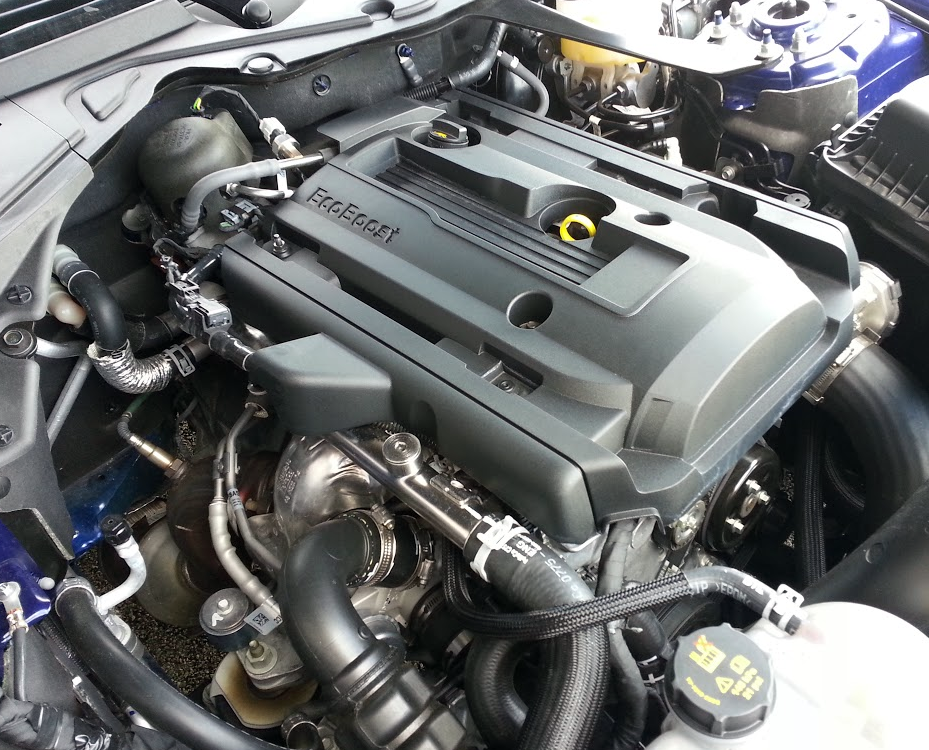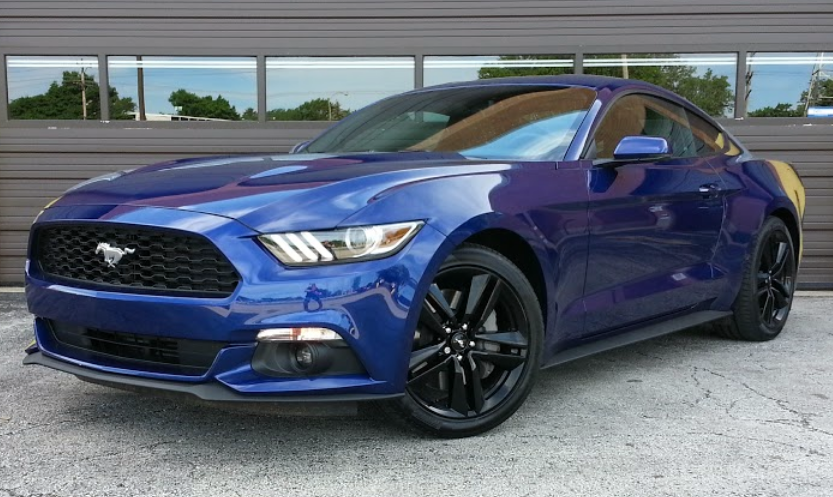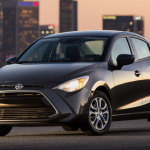
 2015 Ford Mustang Coupe Premium 2.3L EcoBoost
2015 Ford Mustang Coupe Premium 2.3L EcoBoost
Class: Sporty/Performance Car
Dates tested: 6/16/2015 – 6/23/2015
Miles Driven: 522
Fuel Used: 22.4 gallons
Real-world fuel economy: 23.3 mpg
Driving mix: 75% city, 25% highway
EPA-estimated fuel economy: 20/28/23 (city, highway, combined)
Base price: $29,300 (not including $825 destination charge)
Options on test car: Shaker audio system ($1795), Enhanced Security System ($395), adaptive cruise control ($1195), EcoBoost Performance Package ($1995), Premier Trim ($395), reverse park assist ($295), Recaro leather seats ($1595), navigation system ($795)
| CG Report Card | |
|---|---|
| Room and Comfort | B+ |
| Power and Performance | B+ |
| Fit and Finish | B |
| Fuel Economy | B+ |
| Value | B |
| Report-card grades are derived from a consensus of test-driver evaluations. All grades are versus other vehicles in the same class. Value grade is for specific trim level evaluated, and may not reflect Consumer Guide's impressions of the entire model lineup. | |
Price as tested: $38,585
Quick Hits
The great: Refined handling, surprising acceleration for a 4-cylinder
The good: Nicely finished cabin
The not so good: Price climbs quickly as options are added
More Mustang price and availability information
John Biel
History has a way of repeating itself with the Ford Mustang, a car steeped in it after 50 years on the market, and the one constant in the “ponycar” field—a segment that got that nickname when Dearborn’s equine-themed compact sportster took mid-’60s America by storm. Certain styling cues (bodyside cove, triple vertical taillights) and model names (Mach 1, Boss 302) turn up again and again to remind owners and passersby what car this is. Perhaps, then, it shouldn’t be a shock that for 2015 there’s a turbocharged 4-cylinder engine under the hood of some Mustangs.

For the benefit of those who have forgotten, Mustangs were available with a 2.3-liter four—essentially the Pinto engine—from 1974, the start of the Mustang II era, to 1993, a little past the halfway mark of the long reign of “Fox”-platform Mustangs. In 1979-80 and again from ’83 to ’86 there were turbocharged versions, including a high-output job that gave the rare 1984-86 Mustang SVO horsepower to match the 5.0-liter V8 in the concurrent GT model.

Today’s Mustang turbo 4 also displaces 2.3 liters, but this is no Pinto mill. Encased within an aluminum block and head, it is a development of the Ford Focus 2.0-liter EcoBoost engine with different bore and stroke dimensions and a couple fewer cubic inches of displacement than the disco-era 4-banger. Oh, and then there’s the power, too. Kitted out with dual overhead camshafts, direct injection, and an intercooler for the twin-scroll turbo, the 2.3 EcoBoost makes 310 horsepower at 5500 rpm—when fed 93-octane premium fuel—and 320 lb-ft of torque at 3000 revs. At its best in the SVO, the old cast-iron ohc turbocharged engine developed 205 horsepower.
Shelby GT350 Mustang: Relaunching a Legend
The EcoBoost turbo 4 outpowers Mustang’s naturally aspirated 3.7-liter V6, which has been dialed back to 300 horsepower and 270 lb-ft for ’15. Thus, as the performance-upgrade model, a base Mustang EcoBoost coupe is priced $1500 more than a comparable V6 (the latter being available only in basic form). Ponycar shoppers who equate sound with power will likely look askance at the EcoBoost Mustang because it doesn’t fire with a muscular exhaust blast through its twin pipes. It’s more muted, and even under acceleration the sound is more of an increasingly amplified hum (though it gets a little more guttural near the upper end), not a deep burble. Neither, though, does the engine pulse perceptibly at idle like some fours.

So much for sound. As for fury, there’s enough torque to get the 4-cylinder Mustang away from a stop crisply—and to keep drivers who opt for the 6-speed manual transmission from having to downshift a lot to preserve the car’s strength. Turbo lag is hard to detect, a function of the twin-scroll design, but the engine seems to start feeling its oats as it nears 4000 rpm.
Of course, Ford’s major motivation for working up a turbo-4 Mustang is to improve fuel economy. On paper, it does just that: EPA estimates of 21 mpg city/32 highway/25 combined with automatic transmission and 22/31/26 with the stickshift clearly outpace the ratings for the V6 and the GT’s V8. On pavement, though, things are a bit different, at least in this tester’s experience. Driving a manual EcoBoost Premium coupe for 103 miles—85 percent in city-type conditions—yours truly saw just 16.9 mpg. (Note: Two subsequent test drivers observed vastly improved fuel economy, raising our test average.)
By the way, that 6-speed is efficient and precise in its throws; the clutch is slightly stiff but not enough to make it a burden in stop-and-go driving. Overall, it’s a pleasure to drive the car with this gearbox.
Even with the 19-inch wheels and summer tires (in place of standard 18s with all-season skins) from the optional Performance Package added to Consumer Guide®’s test car, there was a nice balance of ride and handling. New for every 2015 Mustang is a switch to independent rear suspension composed of integral links and coil springs. Cornering lean in the test car was extremely well managed, yet ride was composed enough to keep cracks and expansion joints from registering as unpleasant total-car jolts. Putting the four up front takes a little weight off the Mustang’s nose, which makes steering more responsive. The electrically assisted power steering is adjustable to “Normal,” “Sport,” or “Comfort” settings. Normal and Comfort are hard to tell apart, and, frankly, there’s nothing wrong with Normal under nearly any situation. Sport does offer more resistance for track work. The Performance Package also includes disc brakes with larger-than-standard rotors and 4-piston front calipers. These binders are quick and sure in their action.
Test Drive: 2015 Dodge Challenger R/T Scat Pack vs. SRT 392

A flick of a different toggle switch also affects the car’s behavior by summoning a choice of drive modes: “Normal,” “Wet/Snow,” “Sport,” or “Track.” The modes mix modified settings for engine response, electronic-stability-control actuation, and, in automatic-equipped cars, transmission calibrations. Clicking between Normal and Sport modes during his expressway commutes, this driver noticed that the engine certainly felt freer in the latter setting.
Styling inside and out is all new, but is distinctly and historically Mustang. The cabin is modernized and greatly improved. There’s lots of soft-touch material on the usual contact points. The tested EcoBoost Premium sported red stitching on the seats and pleated door centers; brightwork around the controls, on pedal faces, on the steering-wheel spokes, and on the door grips; and a full-width dark-metal panel across the dash with an engine-turned look. Numerals on the side-by-side speedometer and tachometer dials aren’t as narrow and crowded as before. Side, rear, and over-shoulder visibility remains best in class even with a roofline with a windshield and backlight that are more steeply sloped than before. However, looking ahead, a rise in the hood paired with an aero-friendly sloped nose make it a bit of a guess where the actual front of the car is.
CG’s test car was treated to extra-cost Recaro front seats that are pretty much form-fitting (though this driver may not have had the most fitting form for them). Stoutly bolstered, they provide good grip during aggressive maneuvers. These sport seats manually track fore and aft to reach optimal leg and head room, but the standard seats have power adjustment. For all practical purposes, this is a 2-passenger car; leg room in the 2 bucket-like rear seats is all but nonexistent, and limited head room under the fastbacklike roofline rules out occupancy by a huge portion of the world’s adult population. Interior storage includes a usefully sized glove box, 2 open cup holders in the console, long door pockets, and a small console cubby with media-device inputs within.

The trunk has a wide lid, though the space narrows between the taillights. Liftover is a little high, but loading should still be easier than in other cars of its ilk. Space on the flat floor is wide and extends well forward, but isn’t all that tall. There is plenty of room around the compressor in the otherwise-vacant spare-tire well to store some additional items if need be. Rear seats fold 60/40 to provide additional cargo space but they don’t form an uninterrupted surface with the trunk floor, and, not being a hatchback—despite the car’s looks—there’s a fixed package shelf over a bulkhead that restricts the size of items that pass from the trunk.
Significant EcoBoost Premium standard equipment includes a limited-slip axle, LED fog lamps, heated power mirrors, bright exhaust tips, rear spoiler and diffuser, dual-zone climate control, ambient lighting, a tilt-telescoping steering column, SYNC and MyFord Touch infotainment-system management, Track Apps for timing and other performance functions, and a rearview camera. That all comes for a coupe starting price of $29,300. However, the car CG editors drove shot up to $38,585 delivered thanks mostly to big-ticket add-ons like a Shaker 12-speaker audio system, adaptive cruise control, the Recaro seats, and the Performance Package. That makes for one expensive Mustang. Fortunately, the Performance Package, which genuinely enhances the car’s capabilities, is also available with the $25,300 base EcoBoost. Some Mustang customers may have a hard time getting their heads around the idea of a 4-cylinder ponycar, but those who can needn’t break the bank to get a good one.

Fast and Curious: 7 Unusual Star Cars from the “Fast and Furious” Series



